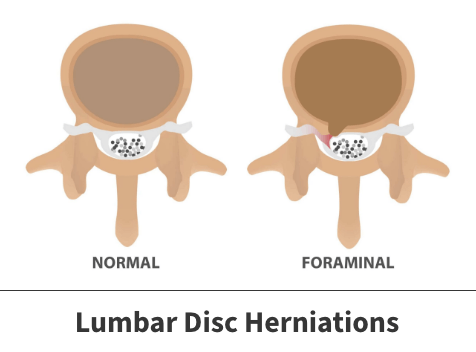Foraminotomy
The spine acts as your body’s foundation. Without it, you would be unable to stand up straight, walk, engage in any exercise, or even move. When the spine or surrounding parts become injured, you may experience severe pain or disability.
Many procedures have been created to cure or limit the impact of spinal injuries. One specific issue is spinal compression. A procedure designed to alleviate and fix it is called a foraminotomy.
Anatomy

Your spinal column is made up of bones called vertebrae which are cushioned by surrounding discs. The vertebrae and discs protect your spinal cord, which contains nerves. These nerves communicate with the brain and enable you to carry out essential functions like feeling, moving, and completing other vital bodily functions.
About
Over time and for various reasons, both vertebrae and discs can become injured. When an injury progresses, bones and tissues could press up against the spinal cord nerves and other parts. This is known as compression.
Causes of spinal cord compression
Any number of conditions could result in spinal cord compression, including:
- Normal age-related deterioration of discs and vertebrae
- Damaging diseases like arthritis
- Disc herniation
- Bulging bones called bone spurs
- Acute injuries after falls, car accidents, or sports-related injuries
Though not as common, spinal cord compression might also result from non-cancerous or cancerous tumors.
Risk Factors
Injuries that lead to spinal compression can happen to anyone at any age. Your chances increase if you have a job that requires you to lift heavy objects or bend repeatedly. Your risk also rises if you have poor posture, engage in incorrect exercising techniques, and participate in highly physical contact sports.

Symptoms
Your symptoms may vary depending on the specific compression-causing problem, but some common ones include:
- Neck and lower back pain and stiffness
- Balance and coordination problems
- Loss of sensation in your hands or feet
- Difficulties walking, standing, or performing once routine activities
- Muscle aches
- Mobility struggles
Advanced spinal compression can result in more severe symptoms, such as loss of bowel or bladder control, numbness in the arms or legs, and crippling weakness – making even the slightest movements challenging.
Complications
If not quickly and properly diagnosed and treated, you could experience disabling pain, severe mobility problems, and possibly even paralysis.
Diagnosis
Your doctor will first do a thorough examination of your neck and back, then test your reflexes and range of motion.
If spinal compression is considered a possible condition, you might need to get an X-ray, MRI (magnetic resonance imaging), or CT (computerized tomography) scan. These diagnostic tools enable your doctor to capture and study images of your spine. You may also be given electromyography – an electrical test measuring your muscle capabilities.
Treatment
If your doctor diagnoses you with spinal compression, you might be a candidate for foraminotomy.
Preparation
You may be asked to stop taking certain medications before the operation. Also, you will likely be required not to eat or drink in the hours leading up to the procedure.
The Procedure
Foraminotomy involves repairing vertebrae or removing blocked spaces surrounding them to relieve pressure on nearby structures like spinal nerves. Your surgeon will most likely perform this in a hospital setting. The procedure is completed under general anesthesia, which means you will be asleep until it is over.
Using a particular type of X-ray, your surgeon makes an incision into your damaged vertebrae and use tools to move aside muscles and other neighboring tissues carefully. Then, either damaged spinal bones are repaired, or blockages in the spaces surrounding the bones are cleared to remove existing pressure.
Recovery
You will probably remain in the hospital for one or two days for monitoring following surgery. Upon returning home, you will be given specific instructions on caring for surgical wounds. You will also need to adhere to a list about which activities you can and cannot take part in. In most cases, a course of physical therapy will be necessary to help you regain strength and motion in your back.
Your line of work will determine when you can get back to action. Those not involved in hard, physical labor may be able to return to their jobs in as little as a few weeks. Those employed in positions demanding significant bending or heavy lifting may need several months of recovery.
Preventing Spinal Compression
Injuries caused by falls, car accidents, and age or illness are challenging to prevent. You might decrease your risk by maintaining correct posture, learning to lift heavy objects properly, avoiding full-contact sports, or wearing protective gear like back braces.
Videos
Related specialties
- Anterior Cervical Corpectomy & Discectomy
- Artificial Disc Replacement (ADR)
- Bone Cement Injection
- Degenerative Disc Disease
- Diffuse Idiopathic Skeletal Hyperostosis (DISH)
- Discectomy
- Discitis Treatment & Information
- Epidural Injections for Spinal Pain
- Interlaminar Implants
- Interlaminar Lumbar Instrumental Fusion: ILIF
- Kyphoplasty (Balloon Vertebroplasty)
- Kyphosis
- Laminectomy: Decompression Surgery
- Lumbar Epidural Steroid Injection
- Lumbar Interbody Fusion (IBF)
- Minimally Invasive Spine Surgery
- Outpatient Spine Surgery
- Pinched Nerve
- Piriformis Syndrome
- Sacroiliac Joint Pain
- Sciatica
- Scoliosis
- Spinal Fusion
- Spondylolisthesis & Spondylolysis
- Vertebroplasty
- Whiplash & Whiplash Associated Disorder (WAD)
